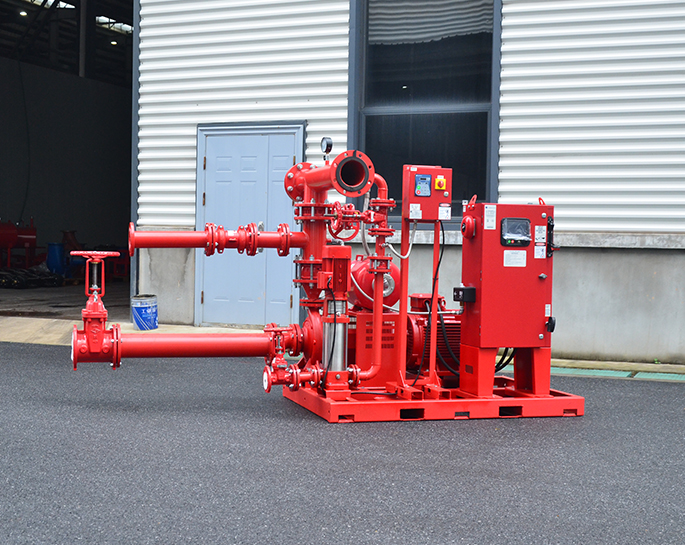How do you ensure fire pumps are ready for emergency use?
Aug 07, 2024
Share:
Ensuring fire pumps are ready for emergency use involves regular maintenance, testing, and following industry standards. Here are the key steps to ensure fire pump readiness:
### Regular Inspection and Maintenance
1. **Weekly Inspections:**
- Check the pump's physical condition.
- Verify no visible signs of leaks or damage.
- Ensure valves are in the correct positions.
2. **Monthly Maintenance:**
- Inspect the pump house or room for cleanliness and ventilation.
- Check the battery electrolyte levels in diesel engine fire pumps.
- Verify oil levels and check for any signs of contamination in diesel engines.
3. **Annual Maintenance:**
- Perform a full inspection and servicing of the pump, motor, and controller.
- Check all electrical connections for tightness and proper operation.
- Replace or service any worn or defective parts.
### Testing
1. **Weekly Testing:**
- Perform a no-flow test (churn test) to ensure the pump starts and runs correctly.
- For electric fire pumps, check the operation of the motor and control system.
- For diesel fire pumps, ensure the engine starts and runs properly.
2. **Annual Flow Test:**
- Conduct a full flow test to verify the pump can achieve its rated flow and pressure.
- Measure and record the flow rates and pressures at different points to ensure performance meets specifications.
- Inspect and test pressure relief valves and check for proper operation.
### Documentation and Record Keeping
- Keep detailed records of all inspections, tests, and maintenance activities.
- Record any issues found and the corrective actions taken.
- Maintain a log of all personnel who performed the inspections and tests.
### Compliance with Standards
- Follow the guidelines and standards set by organizations such as the National Fire Protection Association (NFPA), specifically NFPA 25 (Standard for the Inspection, Testing, and Maintenance of Water-Based Fire Protection Systems).
- Ensure compliance with local fire codes and regulations.
### Training and Procedures
- Train personnel on proper inspection, testing, and maintenance procedures.
- Develop and implement emergency response procedures that include regular drills and simulations.
- Ensure that staff is familiar with the operation of the fire pump and associated systems.
### Remote Monitoring
- Implement remote monitoring systems to continuously check the status of the fire pump and its components.
- Use alarms and notifications to alert personnel to any issues in real-time.
By following these steps, you can ensure that your fire pumps are in a state of readiness and capable of performing effectively in an emergency.

### Regular Inspection and Maintenance
1. **Weekly Inspections:**
- Check the pump's physical condition.
- Verify no visible signs of leaks or damage.
- Ensure valves are in the correct positions.
2. **Monthly Maintenance:**
- Inspect the pump house or room for cleanliness and ventilation.
- Check the battery electrolyte levels in diesel engine fire pumps.
- Verify oil levels and check for any signs of contamination in diesel engines.
3. **Annual Maintenance:**
- Perform a full inspection and servicing of the pump, motor, and controller.
- Check all electrical connections for tightness and proper operation.
- Replace or service any worn or defective parts.
### Testing
1. **Weekly Testing:**
- Perform a no-flow test (churn test) to ensure the pump starts and runs correctly.
- For electric fire pumps, check the operation of the motor and control system.
- For diesel fire pumps, ensure the engine starts and runs properly.
2. **Annual Flow Test:**
- Conduct a full flow test to verify the pump can achieve its rated flow and pressure.
- Measure and record the flow rates and pressures at different points to ensure performance meets specifications.
- Inspect and test pressure relief valves and check for proper operation.
### Documentation and Record Keeping
- Keep detailed records of all inspections, tests, and maintenance activities.
- Record any issues found and the corrective actions taken.
- Maintain a log of all personnel who performed the inspections and tests.
### Compliance with Standards
- Follow the guidelines and standards set by organizations such as the National Fire Protection Association (NFPA), specifically NFPA 25 (Standard for the Inspection, Testing, and Maintenance of Water-Based Fire Protection Systems).
- Ensure compliance with local fire codes and regulations.
### Training and Procedures
- Train personnel on proper inspection, testing, and maintenance procedures.
- Develop and implement emergency response procedures that include regular drills and simulations.
- Ensure that staff is familiar with the operation of the fire pump and associated systems.
### Remote Monitoring
- Implement remote monitoring systems to continuously check the status of the fire pump and its components.
- Use alarms and notifications to alert personnel to any issues in real-time.
By following these steps, you can ensure that your fire pumps are in a state of readiness and capable of performing effectively in an emergency.


.png)
.png)

.png)


